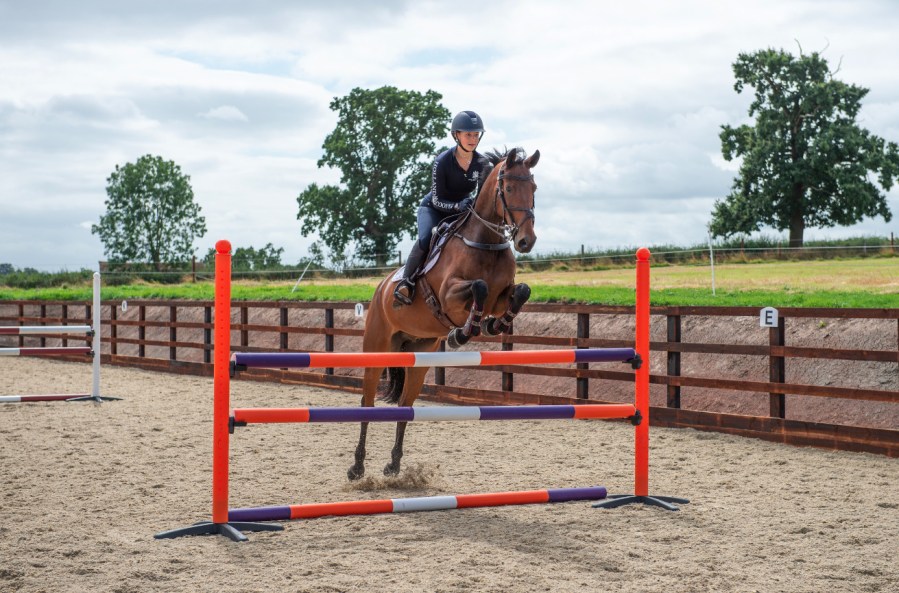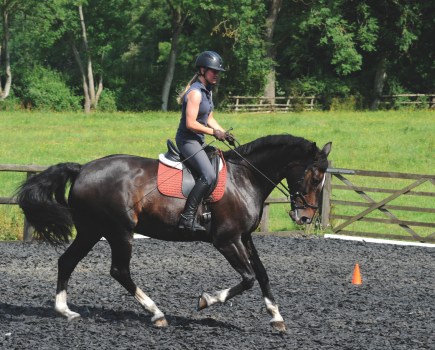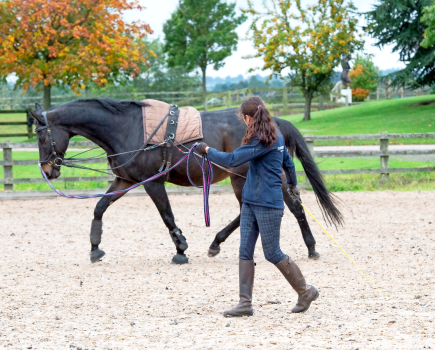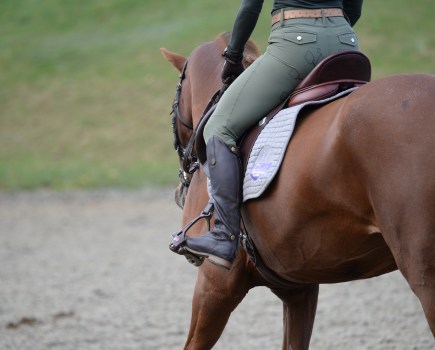A clear showjumping round secured victory at Badminton CCI5* for Piggy March in 2019 — and her prowess in this phase has helped her secure other big titles (Burghley 2022) and championship medals (European team gold and individual silver in 2021) since then. So if you’re seeking advice for how to nail the perfect warm-up and establish a winning routine for jumping a clear round in the arena, Piggy March is one of the best riders in the world to ask.
Having a plan in place for what you’re going to do with your horse and when will help you feel confident, in control and give yourself the best chance of enjoying a competition day that goes smoothly.
This involves factoring in enough time to walk your showjumping course and warming up properly. There’s nothing more nerve-wracking than arriving with very little time to spare, which means you’re in a rush and have to cut corners, potentially leaving you feeling unprepared.
Piggy March reveals how she prepares to jump a clear round at a show:
Walk the course
Whether you’re taking part in a showjumping class or out eventing, one of the best ways to succeed and jump a clear round is to walk your course well. You need to know the exact line you’re going to ride each fence and walk your distances, especially in the combinations.
“In eventing, the optimum time is getting tighter,” says Piggy. “It’s annoying and frustrating to jump a nice clear round only to hear the commentator announce that you’ve clocked up a few time penalties.”
To avoid this, when you’re walking your course be economical with the lines you’re going to ride, but make sure your approach to each fence is straight.
Utilise the collecting ring
As you get into the collecting ring, check with the steward whether the class is running to time and ask them to put your number down on the board. Count how many riders are in before you. You’ll need a little time to warm your horse up on the flat in trot and canter before you start jumping.
Just like your dressage warm up, you’re checking your horse is on your aids and focused. Use transitions and changes of rein to ensure your horse is really listening to you.
“Stay focused in the warm up and ride your horse — try not to freeze and leave them to their own devices,” advises Piggy. “Keep working on the quality of your canter and the straightness to your fences and on landing too.
“Focus your mind on your horse’s way of going and trying to make that the best you possibly can, rather than thinking too much about the course you’re going to jump and the inevitable fences that may be playing on your mind.”
Don’t start jumping too soon
“I usually start jumping my horse in the warm up when there’s six to go before me,” explains Piggy. “This gives me enough time to jump the fences, plus a little extra in case I have any problems.”
The key thing to remember is don’t jump too big, too quickly, and try to stick to your jumping warm up plan so you remain focused.
Once you’ve jumped all the fences you want, give your horse a bit of a breather for a few minutes. As the competitor before you is in the ring, jump one more fence to make sure your horse is on the ball and listening to you.
Which warm-up fences?
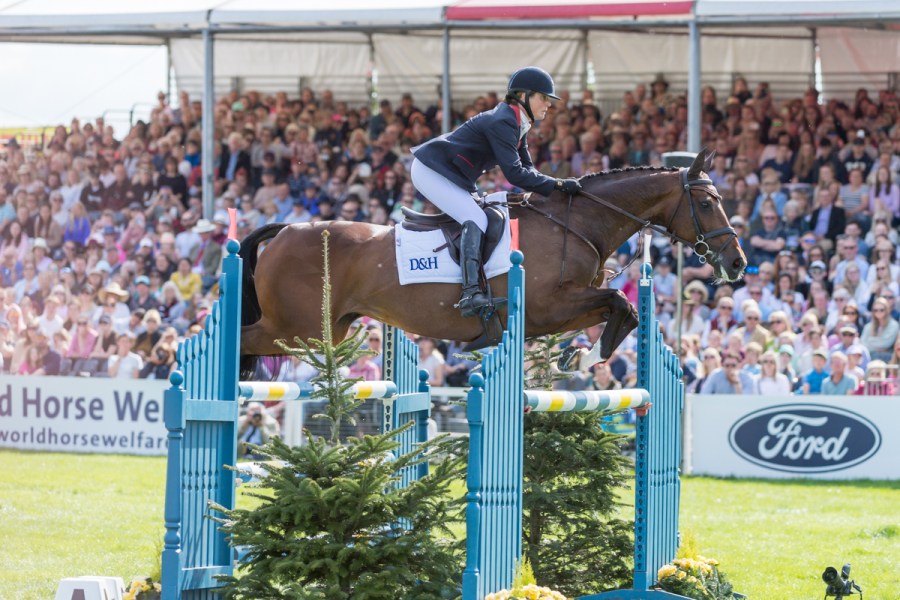
Piggy March and Vanir Kamira at Badminton 2022. Credit: Trevor Holt
The aim of your warm up is to encourage your horse to focus and use their brain, and encourage them to make a good shape over fences. Piggy March uses the following fences to warm up:
Warm-up fence 1: Cross-pole
“This type of fence is always a good choice as your first fence to jump. It’s nice and inviting and the shape of it helps you ride a straight approach,” says Piggy.
How to ride it
- It can be wise to approach in trot to begin with, especially if you’re on a young horse. It gives them a chance to work out what you’re asking them to do.
- You only need to jump a cross-pole a few times, until your horse is jumping it quietly and confidently.
- Focus on having a straight approach and maintaining a rhythmical canter.
Warm-up fence 2: Vertical
“Progressing on from your simple cross-pole, build an upright fence with a ground pole a little way out to make the jump look inviting, which will give your horse confidence,” says Piggy.
How to ride it
- Approach the fence in canter.
- Keep your horse straight and aim for the middle of the jump.
- Keep your chin up, riding positively from your leg into an even contact down both reins.
- Jump this fence a few times, before increasing the height by a couple of holes until it’s the same as in your class. Piggy says she doesn’t see the need to jump bigger in the warm up arena compared to the class height.
Warm-up fence 3: Oxer
“Start off with a fairly small oxer, with the front rail a little lower than the back rail,” advises Piggy. “Position a ground pole away from the fence so it gives the feel of jumping a triple bar. This will encourage your horse to get in the air and to reach for the back rail.”
How to ride it
- Jump an oxer a few times, increasing the height and width until it’s at the height you’ll be jumping in the ring.
- After each jump, square the oxer up slightly in front and move the ground pole in so it’s a more vertical fence. The end goal is an up-to-height square over with ground pole tucked in at the bottom of the fence.
- You’re simply changing the look of the oxer, so keep the way you approach it the same, making sure you have a good canter rhythm. Then leave the rest of the thinking to your horse.
Warm-up fence 4: Vertical
“To finish, go back to a vertical fence but roll the ground pole in or put it up onto some cups so that you have a very upright vertical which isn’t quite as inviting,” says Piggy.
Ride into the ring with confidence
When it’s your turn to jump, Piggy March advises trotting confidently into the ring and letting your horse have a bit of a look around before asking for canter.
You should know what rein you’re going to approach the first fence on, so make sure you stick to your plan, and once the bell rings start your approach to the fence.
Ride positively from your leg and maintain a balanced, rhythmical canter. Keep your chin up and look ahead to your next fence. Use the corners to re-balance your horse — this will help you ride good lines and give them the best chance to jump clear.
Lead image: copyright Your Horse Library/Kelsey Media Ltd. Please note Piggy March is not pictured riding
Related articles
- Piggy March: jump out of trot to test rider balance and build trust in your horse
- Nine course-walking tips from Olympic showjumping champion Ben Maher
- Five of the most common jumping position problems and how to address them
- Why does my horse refuse? Three reasons and exercises to solve them
- Feeling the pressure? Manage competition nerves with performance coach Annika McGivern *video*

